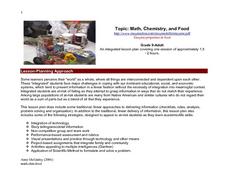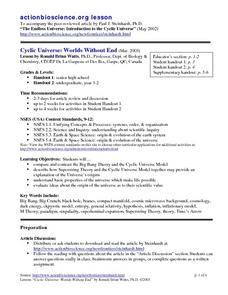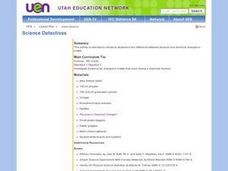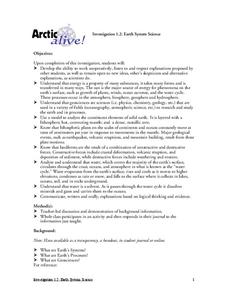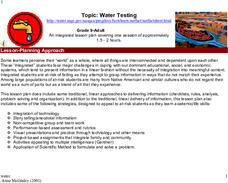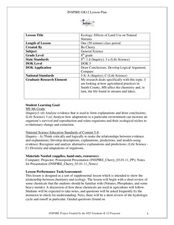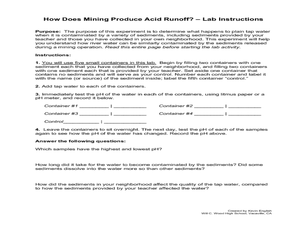Curated OER
The Chemistry of Water / Industrial Waste at My High School
Students gain factual knowledge of the nature of industrial waste at on their school site. They gain process knowledge of the laboratory techniques and collection procedures for wastewater samples.
Curated OER
Topic: Math, Chemistry, and Food
Students listen as the teacher tells the story of Sisyphus rolling the stone up the mountain. Students prepare two batches of jello, one with fresh pineapple, and one with canned pineapple. While the jello is setting, students work on...
Curated OER
Super Glue Fuming of Latent Fingerprints
Students explore latent fingerprinting. They observe a supervised demonstration of the process that real-life crime scene investigators sometimes use to identify latent fingerprints. In addition, they brainstorm ways to improve the...
Curated OER
Where's the Oxygen?
Students study seawater and how temperature and salinity influence it. In this oxygen lesson students complete a lab activity on dissolved oxygen.
Curated OER
Teaching About the Properties of Water
Learners use video, Internet research, graphs and tables, worksheets and hands-on experiments to investigate the properties of water in a lake environment. They work under direction or through an inquiry process.
Curated OER
Cyclic Universe: Worlds Without End
Students compare and contrast the Big Bang Theory and the Cyclic Universe Model. They explain basic properties of the univers which make life possible. They evaluate ideas about the origin of the universe as to their scientific value.
Curated OER
Building A Topographic Model
Students visualize, in three dimensions, features represented by contour lines on a topographic map. They see that the different elevations shown on a two dimensional topographic map can be used to build a 3-D model.
Curated OER
Science Detectives
Fifth graders examine the differences between chemical and physical changes. As a class, they are read a scenerio and determine whether it was deliberate act or not. In groups, they observe the changes of an alka-seltzer tablet and...
Curated OER
Ocean Planet: Pollution Solution
Pupils explore the concept of environmental stewardship. In this science instructional activity, students investigate the impact of oil spills as they discuss historical spills. Pupils use problem solving skills to brainstorm clean-up...
Curated OER
Our Universe: Designed or Evolved?
Students brainstorm and write arguments for Evolution and Intelligent Design. They research the history of each of these ideas. They also examine the controversy of teaching one or both ideas in schools.
Curated OER
Thinking about Energy
Young scholars examine their understandings about energy concepts by completing an online survey. Students participate in a class discussion about their uses of resources and the differences between perpetual, renewable, and...
Curated OER
Saving Humpty Dumpty;Recycling, Environmental Science, Math, Ecology, Athletic Shoes
Learners describe how shoe design, manufacturing, retailing, consumer use, and disposal impact environments and societies. They discuss ways to reduce, reuse, or recycle resources in the life-cycle for a shoe product.
Curated OER
Earth System Science
Students explore the Earth and its ability to support life. They discuss the geosphere and the water cycle and complete the Water Wonders activity. After completing the activity, they respond in their journals and reflect upon the...
Curated OER
A Pre-Treatment Model for Ethanol Production Using a Colorimetric Analysis of Starch Solutions
Students recognize the benefits of ethanol and study photosynthesis. In this ethanol instructional activity students complete an experiment that shows the procedure that starch can be hydrolyzed by salivary amylase.
Curated OER
Are Polymers Photodegradable?
Learners study the term photodegradability and how it applies to the 6-pack loop ring. In this materials lesson plan students test photodegradability of the 6-pack plastic ring.
Curated OER
Root, Root, Root for the Nutrients
Students observe the growth of a seed, predict what will happen when seeds are planted without soil, and conduct an experiment using a hydroponics system.
Curated OER
Where is That Light Coming From?
High schoolers investigate the chemistry of bioluminescence and discuss how various organisms benefit from this trait. They prepare a report about of at least one organism that receives each of the benefits discussed.
Curated OER
Water Testing
Students work together to design their own experiment to test developed hypothesis about the minerals in water. As a class, they discuss the main components of water quality and describe the chemistry behind the hardness assay. They...
Curated OER
Fallout!
Students plot the locations of fallout from two disasters that polluted much of the world's air. They plot the ash fallout from the 1980 Mt. St. Helen's eruption to see what the wind patterns in the United States look like overall. Next...
Curated OER
Water Quiz
Students use a digital atlas to explore the effects of water on landscapes. They view view pictures and complete worksheets to study the properties of water. Students study the water cycle and the chemical role it plays in living cells.
Curated OER
Ecology: Effects of Land Use on Natural Streams
Eighth graders examine how humans affect various ecosystems. In this ecology instructional activity, 8th graders discuss different ways that contaminants enter the stream. They explain the consequences of eutrophication in lakes.
Curated OER
How Does Mining Produce Acid Runoff?
Students examine how mining and other industry operations can lead to acid runoff. In this mining lesson students study weathering and complete a lab on it.
Curated OER
Famous Scientists
In this famous scientists worksheet, students are provided with a list of 83 scientists from various fields of science to choose from for research.
Curated OER
Nanaotechnology: Small Science, BIG DEAL!
Students read an article that introduces them to the science and applications of nanotechnology. They discuss the the everyday examples of how nanotechnology is and can be used. In small groups, they observe and make inferences about...



